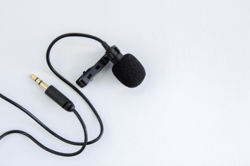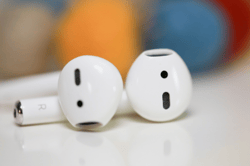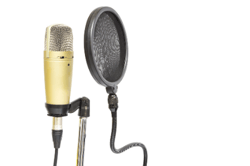The nuances of sound in Web Conferencing
With the increased level of web conferencing, having crystal clear sound is more important than ever. No one wants to be on a call and have to keep asking the speaker to repeat themselves. And conversely, no one wants to be the person having to repeat themselves two, three or four times in order to be understood.
Bad sound quality makes conversation difficult.
Today we will explore areas where you can quickly and affordably improve your sound quality with a crystal clear voice and minimal background noise.
The English alphabet has 26 letters and used individually or in combination they represent between 42-44 different sounds. Add on top of that accent and dialect and the number exponentially increases.
The goal is to achieve the best audio quality, regardless of accent or dialect, in a web conferencing environment. We are trying to get as close to studio quality sound as possible. This needs to be achieved on a budget for you to be able to use in your home with kids running around and dogs barking. And we need our web conferencing kit to travel well because our office today is not always going to be our office tomorrow.
Let’s start by examining 4 different types of microphones, the pros and cons of each and then review budget considerations.
- Lapel microphone - Under $35 was tested
- Bluetooth Mic for Phone and Computer - Under $200 was tested
- Condenser microphone - Under $75 was tested
- Shotgun microphone - Under $100 was tested
 Lapel microphones are a good source of sound for the money and for the most part, the old corded cell phone headsets use the same concept. From Amazon I picked up a good lapel microphone for under $30.
Lapel microphones are a good source of sound for the money and for the most part, the old corded cell phone headsets use the same concept. From Amazon I picked up a good lapel microphone for under $30.
Currently this microphone gets used to record presentations that will be recorded and played at a later time. It offers better sound quality pickup than the computer microphone. Additionally, if you are only using a headshot or just have a voice behind a presentation then the lapel microphone is not even visible.
Pros: Cheap for good quality.
Cons: Cord can be difficult at times if not long enough. Microphone must be positioned correctly.
 The Cell Phone Bluetooth Headset is an over the ear headset that uses bluetooth to connect to the phone and to the computer. For this test I used a Plantronics Voyager 5200 that cost $180 new when it was purchased.
The Cell Phone Bluetooth Headset is an over the ear headset that uses bluetooth to connect to the phone and to the computer. For this test I used a Plantronics Voyager 5200 that cost $180 new when it was purchased.
Pros: I already had one. No additional cost
Cons: You sort of look like a cyborg. Unless you use an external source for sound (on the receiving side) you are limited to hearing the speaker in one ear. You DO NOT get the same sound quality as using a condenser microphone.
After a few months of trying different setups, I have concluded that the DualBand option is the least expensive most efficient use of money. It serves the purpose of a phone headset and works well with web conferencing. Add on top of that the noise canceling technology deployed in many of these devices, these make for great work from home devices.
 Condenser microphones are the ones that you see many recording artists use. They are often hanging upside down. With talk show hosts, they are sometimes on a tripod on a desk or on a boom arm.
Condenser microphones are the ones that you see many recording artists use. They are often hanging upside down. With talk show hosts, they are sometimes on a tripod on a desk or on a boom arm.
Regardless of how they are placed, a good condenser microphone helps to pick up a larger sound range than your typical headset or lapel microphone.
The reason that you often see the little screen in front of the microphone is that it needs to be very close to the speaker to be best utilized. When the speaker speaks a “p” sound for instance, air comes out of the mouth at a good rate. Without the filter, this air will distort the sound picked up by the microphone.
Without getting too deep into the weeds, there are several types of condenser microphones with one of the big difientrators being the range at which the microphone picks up sound.
Think about how wide your vision is and then think about “tunnel vision.” More expensive microphones have a larger range and less expensive microphones have a smaller range. Unless you are interviewing people at your desk for audio quality, then there is not a need to get a condenser microphone that has three different “pickups” that allows for a ultra wide range.
With this in mind, I ordered an inexpensive condenser microphone with boom. The FIFINE T669 microphone. It came recommended from an industry expert as a good starter microphone. My biggest concern was that it would get in the way of my face and I am not sure I want to take away facial cues from a web conferencing experience.
After a quick installation, I found that I could mount the boom to the side and behind the video camera. When presenting it takes up the far left corner of the screen and does not hide my face.
In early testing, when switching from the condenser microphone to the computer microphone, the end user noticed a difference in tone quality. I surveyed several different LinkedIn connections and will continue to survey more throughout this process and update the data accordingly.
Pros: Voice quality improved over computer and Dual Band Microphone.
Cons: Need to be aware of how far the microphone is from mouth. If over 8 inches, the built- in microphone on the computer is better. Not very transportable. Packaging from the store is often adequate to make several trips but will need to purchase a real carrying case if you travel often. If you did not take the boom arm and only the tripod stand it would fit in a padded container about the size of a child's lunchbox.
Previous Post: Empowering Success In A Post COVID Economy With Web Conferencing
Next post: Shotgun mics, sound dampening, and reverberation and feedback.
